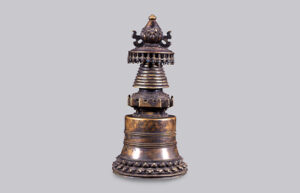
About the Meditation
This week’s meditation session is led by Sharon Salzberg and the theme is Appreciation.
The guided meditation begins at 11:51.
For centuries Himalayan practitioners have used meditation to quiet the mind, open the heart, calm the nervous system, and increase focus. Now Western scientists, business leaders, and the secular world have embraced meditation as a vital tool for brain health.
Whether you’re a beginner, a dabbler, or a skilled meditator seeking the company of others, join expert teachers in a 45-minute weekly program designed to fit into your lunch break. Each session is inspired by a different work of art from the Rubin Museum’s collection and includes an opening talk, a 20-minute meditation session, and a closing discussion.
Presented in partnership with Sharon Salzberg and the Interdependence Project and Parabola Magazine.
RELATED ARTWORK

Theme: Appreciation
The stupa is a symbol found across all Buddhist traditions. It originated in India as a mound made to hold sacred remains, like those of the historical Buddha Shakyamuni. This is not limited to the mortal remains of a holy person but may also include objects associated with that person, such as clothes, as well as sacred texts, articles of worship, and figures made of clay and the ashes of the deceased (tsa tsa). While a statue or painting of a buddha represents the divine body of an enlightened being and a book symbolizes divine speech, a stupa represents the mind of supreme spiritual awakening and is thus a symbol of buddhahood.
There are several different traditional types of stupa, and this metal sculpture is an example of a Kadam stupa and can be differentiated from other kinds of stupas by its bell-like shape. This style of stupa was introduced to Tibet by the Indian scholar Atisha (982–1054) in the mid-11 century.
About the Speaker

Tracy Cochran has been a student and teacher of meditation and spiritual practice for decades. She is the founder of the Hudson River Sangha, which is now virtual and is open to all. The link for her weekly meditations can be found on her website: tracycochran.org. In addition to Tracy has taught mindfulness meditation and mindful writing at the Rubin Museum of Art and the New York Insight Meditation Center, as well as in schools, corporations, and other venues worldwide. She is also a writer and the editorial director of Parabola, an acclaimed quarterly magazine that seeks to bring timeless spiritual wisdom to the burning questions of the day. Her writings, podcasts, and other details can be found on her website and on parabola.org.
This program is presented in partnership with Sharon Salzberg and teachers from the New York Insight Meditation Center, the Interdependence Project, and Parabola Magazine and supported by the Frederick P. Lenz Foundation for American Buddhism.

